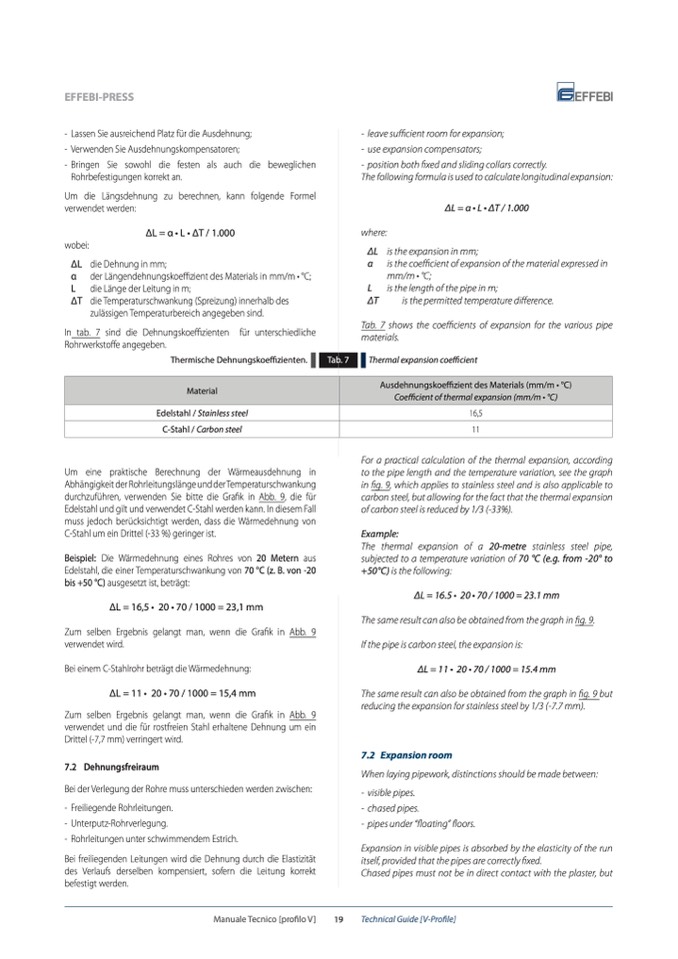
EFFEBI-PRESS
- Lassen Sie ausreichend Platz für die Ausdehnung;
- Verwenden Sie Ausdehnungskompensatoren;
- Bringen Sie sowohl die festen als auch die beweglichen
Rohrbefestigungen korrekt an.
Um die Längsdehnung zu berechnen, kann folgende Formel
verwendet werden:
∆L = α • L • ∆T / 1.000
wobei:
∆L die Dehnung in mm;
α der Längendehnungskoeffizient des Materials in mm/m • °C;
L die Länge der Leitung in m;
∆T die Temperaturschwankung (Spreizung) innerhalb des
zulässigen Temperaturbereich angegeben sind.
In tab. 7 sind die Dehnungskoeffizienten f
ür unterschiedliche
Rohrwerkstoffe angegeben.
Thermische Dehnungskoeffizienten.
Um eine praktische Berechnung der W
ärmeausdehnung in
Abhängigkeit der Rohrleitungslänge und der Temperaturschwankung
durchzuführen, verwenden Sie bitte die Grafik in Abb. 9, die für
Edelstahl und gilt und verwendet C-Stahl werden kann. In diesem Fall
muss jedoch berücksichtigt werden, dass die Wärmedehnung von
C-Stahl um ein Drittel (-33 %) geringer ist.
Beispiel: Die Wärmedehnung eines Rohres von 20 Metern aus
Edelstahl, die einer Temperaturschwankung von 70 °C (z. B. von -20
bis +50 °C) ausgesetzt ist, beträgt:
∆L = 16,5 • 20 • 70 / 1000 = 23,1 mm
Zum selben Ergebnis gelangt man, wenn die Grafik in Abb. 9
verwendet wird.
Bei einem C-Stahlrohr beträgt die Wärmedehnung:
∆L = 11 • 20 • 70 / 1000 = 15,4 mm
Zum selben Ergebnis gelangt man, wenn die Grafik in Abb. 9
verwendet und die für rostfreien Stahl erhaltene Dehnung um ein
Drittel (-7,7 mm) verringert wird.
7.2 Dehnungsfreiraum
Bei der Verlegung der Rohre muss unterschieden werden zwischen:
- Freiliegende Rohrleitungen.
- Unterputz-Rohrverlegung.
- Rohrleitungen unter schwimmendem Estrich.
Bei freiliegenden Leitungen wird die Dehnung durch die Elastizität
des Verlaufs derselben kompensiert, sofern die Leitung korrekt
befestigt werden.
- leave sufficient room for expansion;
- use expansion compensators;
- position both fixed and sliding collars correctly.
The following formula is used to calculate longitudinal expansion:
where:
∆L
α
L
∆T
∆L = α • L • ∆T / 1.000
is the expansion in mm;
is the coefficient of expansion of the material expressed in
mm/m • °C;
is the length of the pipe in m;
is the permitted temperature difference.
Tab. 7
Tab. 7 shows the coefficients of expansion for the various pipe
materials.
Thermal expansion coefficient
For a practical calculation of the thermal expansion, according
to the pipe length and the temperature variation, see the graph
in fig. 9, which applies to stainless steel and is also applicable to
carbon steel, but allowing for the fact that the thermal expansion
of carbon steel is reduced by 1/3 (-33%).
Example:
The thermal expansion of a 20-metre stainless steel pipe,
subjected to a temperature variation of 70 °C (e.g. from -20° to
+50°C) is the following:
∆L = 16.5 • 20 • 70 / 1000 = 23.1 mm
The same result can also be obtained from the graph in fig. 9.
If the pipe is carbon steel, the expansion is:
∆L = 11 • 20 • 70 / 1000 = 15.4 mm
The same result can also be obtained from the graph in fig. 9 but
reducing the expansion for stainless steel by 1/3 (-7.7 mm).
7.2 Expansion room
When laying pipework, distinctions should be made between:
- visible pipes.
- chased pipes.
- pipes under “floating” floors.
Expansion in visible pipes is absorbed by the elasticity of the run
itself, provided that the pipes are correctly fixed.
Chased pipes must not be in direct contact with the plaster, but
Material
Ausdehnungskoeffizient des Materials (mm/m • °C)
Coefficient of thermal expansion (mm/m • °C)
Edelstahl / Stainless steel
16,5
C-Stahl / Carbon steel
11
Manuale Tecnico [profilo V]
19
Technical Guide [V-Profile]

